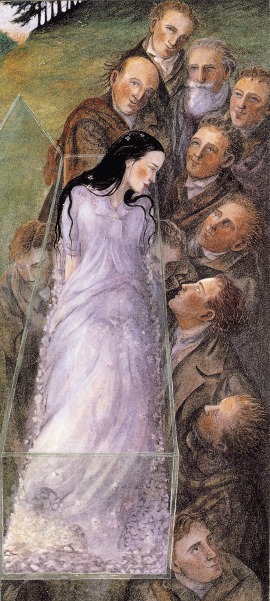[转] 原来爱情是最不重要的...
我的一个朋友最近才和妻子离婚了,我们都觉得奇怪,他的妻子是在他最困难的时候走近他的,在他被所有的人抛弃的时候向他伸出爱之手的,这一路的风风雨雨是我们所看到过的,这一路的艰难困苦也是我们所共同目睹的。 而现在,在他妻子的努力下,他的生活慢慢的好了,乡下的父母也接到城里来了,他却和妻子离婚了,他告诉我们,他没得选择,他的母亲极不喜欢他的妻子,他只能在母亲与妻子中选择一个,而且他说,母亲只能有一个,妻子却可以再一次的选择。 我约他的妻子喝过一次茶,温温柔柔的小女子,满眼的忧伤让人顿生无数怜爱。我试着问她离婚的原因,小女子只是含着泪摇头“我做不到他母亲所要求的媳妇。”然后无语。我接触过她的前任婆婆,我也知道她对媳妇的所谓之的要求,在她家做客的时候,我满耳朵听到的都是她对这个媳妇的挑拨。 而这个小女子居然就这样平平静静的走出了她付出了无数的家庭,而这个男人居然就这样放弃了曾对他有恩的一个小女子,原因只是他太爱她,但是在母亲与妻子中他只能选择一个。
又有一个朋友与远方的他相爱了,相互间的吸引激起了无数的火花,每个深夜,彼此间的电波交流,彼此心与心的呼喊。她告诉我,他是她所遇到过的最能让她心动的男子,而他却是我网络上的一个朋友,于是我也经常听到他在告诉过我,他惊叹今日今时才遇到他心中的女子。 两个相爱的人,恨不能穿越千山万水分分相守,电话电波已经无法承载他们的爱情,每月的电话费也让他们节衣缩食。于是,我说你们上网吧,写你们的相思,写你们的爱恋。 这样我每次上网时总能看到他们在彼此写着一些只有对方才看得懂的文字,当然这些文字会被扫掉的,每当这时,我总会复制下来,日子久了,他们的文字居然让我整理出了几万字的情语情话。 就在我准备将这些文字整理发表时,他们突然的从版面上消失了,而且告诉我永远不会来了,因为他们永远的结局了。我很莫明其妙,因为他们之间的深情曾经深深的感动着我,他们彼此的依恋曾让我在无数个夜里落泪。这样相爱的两个人居然说结束就结束了。 我问为什么,两个人同时告诉我,因为彼此距离太远了,他不可能放弃一切到她的城市来,而她也抛不下所有去他的身边。就这样两个人因为距离慢慢的放手,慢慢的任一段爱消失了。
身边还有许多这样的例子,身边还有许多这样的朋友,看他们相爱的时候春花秋月,牵手相拥,恨不能生生世世相守。而结束的时候往往会有这样与那样的原因,有的说因为父母不同意,不想伤父母的心;有的说两个人的条件相差太多,有的人说年龄相差太多,有的人说距离相差太远…… 而且这许许多多的原因都是很重要的,父母不同意以后的家庭关系会搞不好,两个人条件相差太多会让以后的生活不和,年龄是最大的问题,相差太多思想没办法沟通,距离怎么能让爱相守呢,还是找个身边的人相爱现实的多……
是啊,有这么多的问题摆在面前,这相爱的两个人怎么能不就结束了呢。只是当初相爱时这一切不是明摆的吗?为什么要等到爱深了,情浓了,离不得,弃伤心的时候了才将这一切又重新摆放出来将自己的爱情打得粉碎?
是啊,这一切的一切都很重要,父母重要,工作重要,地位重要,身份重要,房子重要,朋友重要……这么重要的东西,一样也不能放弃,这么重要的东西,舍了一样生活这会变得艰难了。
只有爱情是最不重要的,只有爱情是最容易舍弃的,因了任何一个原因,我们都可以放弃爱情,管他曾经的山盟海誓,管他以前的花前月下,管他彼此的难舍难分,管他痛哭与眼泪,舍了就舍了,弃了就弃了。
原来除了爱情以外,什么都是重要的,原来什么都重要,只有爱情是最不重要的……
又有一个朋友与远方的他相爱了,相互间的吸引激起了无数的火花,每个深夜,彼此间的电波交流,彼此心与心的呼喊。她告诉我,他是她所遇到过的最能让她心动的男子,而他却是我网络上的一个朋友,于是我也经常听到他在告诉过我,他惊叹今日今时才遇到他心中的女子。 两个相爱的人,恨不能穿越千山万水分分相守,电话电波已经无法承载他们的爱情,每月的电话费也让他们节衣缩食。于是,我说你们上网吧,写你们的相思,写你们的爱恋。 这样我每次上网时总能看到他们在彼此写着一些只有对方才看得懂的文字,当然这些文字会被扫掉的,每当这时,我总会复制下来,日子久了,他们的文字居然让我整理出了几万字的情语情话。 就在我准备将这些文字整理发表时,他们突然的从版面上消失了,而且告诉我永远不会来了,因为他们永远的结局了。我很莫明其妙,因为他们之间的深情曾经深深的感动着我,他们彼此的依恋曾让我在无数个夜里落泪。这样相爱的两个人居然说结束就结束了。 我问为什么,两个人同时告诉我,因为彼此距离太远了,他不可能放弃一切到她的城市来,而她也抛不下所有去他的身边。就这样两个人因为距离慢慢的放手,慢慢的任一段爱消失了。
身边还有许多这样的例子,身边还有许多这样的朋友,看他们相爱的时候春花秋月,牵手相拥,恨不能生生世世相守。而结束的时候往往会有这样与那样的原因,有的说因为父母不同意,不想伤父母的心;有的说两个人的条件相差太多,有的人说年龄相差太多,有的人说距离相差太远…… 而且这许许多多的原因都是很重要的,父母不同意以后的家庭关系会搞不好,两个人条件相差太多会让以后的生活不和,年龄是最大的问题,相差太多思想没办法沟通,距离怎么能让爱相守呢,还是找个身边的人相爱现实的多……
是啊,有这么多的问题摆在面前,这相爱的两个人怎么能不就结束了呢。只是当初相爱时这一切不是明摆的吗?为什么要等到爱深了,情浓了,离不得,弃伤心的时候了才将这一切又重新摆放出来将自己的爱情打得粉碎?
是啊,这一切的一切都很重要,父母重要,工作重要,地位重要,身份重要,房子重要,朋友重要……这么重要的东西,一样也不能放弃,这么重要的东西,舍了一样生活这会变得艰难了。
只有爱情是最不重要的,只有爱情是最容易舍弃的,因了任何一个原因,我们都可以放弃爱情,管他曾经的山盟海誓,管他以前的花前月下,管他彼此的难舍难分,管他痛哭与眼泪,舍了就舍了,弃了就弃了。
原来除了爱情以外,什么都是重要的,原来什么都重要,只有爱情是最不重要的……





